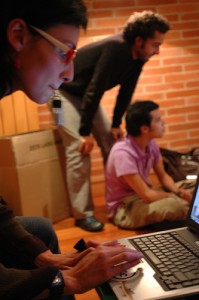We are excited and happy that the Library of Congress digital preservation program is now part of the blogosphere.
Our official name is the National Digital Information Infrastructure and Preservation Program, or NDIIPP (pronounced “n-dip”).
You might find the acronym cryptic. But the name packs in a lot of meaning and a big mission. Plus, it kind of grows on you.
When Congress directed the Library to undertake a national digital preservation program in 2000, the intent was to address the challenge of digital preservation on a broad scale. It was then obvious that our society was generating huge amounts of digital content that had no print equivalent.
Equally clear was that some percentage of this digital content had enduring value for documenting a record of our time. But creation of digital information has far outpaced our national ability to keep content accessible over time. Technological churn and change left important information at risk of loss. In forming NDIIPP, Congress sought to lessen this risk.
Over the last 10 years we have built a national network of collaborative partnerships to help preserve important digital content, build new tools and develop best practices. The partnerships span different communities, including universities, federal and state government agencies and the commercial creative content industry. This is a new approach. Libraries, archives and other memory institutions traditionally have worked separately to acquire and manage their collections. But digital is different—it calls for a new kind of capacity that is difficult for a single institution to build on its own. The only practicable way forward is collaboration: in building technical infrastructure, in sharing knowledge, in developing best practices and in assigning roles and responsibilities for stewarding digital collections.
Collaboration is a great subject to talk about but hard to actually do. There are a host of barriers, often social, that can block action at any point.
That’s why it is often said that technology is the easy part of digital preservation; social is the hard part. We have always done our best to remember this, and have put a lot of effort into outreach and engagement.
Face to face meetings are great, but as a practical matter a good bit of our outreach has taken place via the internet, which I suppose is fitting. Our website, digitalpreservation.gov, has grown into a rich collection of information and resources. We have interviewed experts, listed tools and services, reported on meetings and shared information from around the world.
We want to do even better. There are more perspectives to explore, more practices to share, more ways to engage with all organizations that have a stake in preserving access to digital information. The audience for us to interact with is potentially vast, as we are very interested in personal digital archiving: helping individuals and families preserve their digital photographs and other digital files that document their lives.
This is why we are launching this blog. We’re drawing on the amazing talent and energy of the NDIIPP staff to talk about current issues and solutions relating to digital stewardship.
We’ll spend time looking at the very big (such dealing with huge scientific databases) and the very small (managing modest collections of personal digital documents). There will be lively interviews with people from many fields. It will be practical. It will be fun.
We’re looking forward to your comments, including ideas for what we should explore in these pages.


